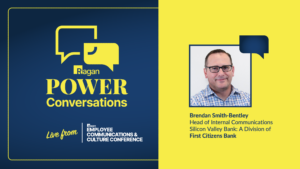Teach managers to consider the what, how, who, and why of each communication
Follow this guidance to help your team leads become vital conduits for clarity, empathy and efficient messaging.

How often have you left a meeting with your manager and thought, “What just happened? What does she want me to do? Why am I doing this?”
Managers are the glue that keep organizations together, and they can be the demise of any organization as well. Managers sit in the middle between leadership making decisions for the business and the employees who must carry out these decisions. The key to bringing the two ends together is communication.
Communication is the exchange of information through speech, writing, visualization, and/or behavior. Communication involves a sender, message and recipient. Sounds like a simple formula for success, right? Not so much.
Communication comes in all shapes and sizes and poses an opportunity to make a connection, inspire motivation and solidify commitment. Communication can also drive a wedge, elicit negativity, or even spark an argument. On one end of the communication spectrum there are the one-off conversations in the hallway, or more likely while waiting for others to join a Zoom meeting or at its tail end. On the other there are communications that require months of planning behind closed doors. Although these two scenarios are very different, they can both be successful or a disaster.
Planning and documentation pay off
All communications benefit from planning. Even a minute of thought can increase the likelihood of an effective exchange. During planning, managers can ask themselves what, how, who and why. They should poke holes in the initial answers and consider potential questions and how they will answer them.
Document all communications. Send an email prior to a meeting that outlines the agenda and goals for the meeting. If an ad hoc discussion lands on actions for the employee or considerations for a change of direction, follow up with an email or other documentation. This follow-up could include others and could go beyond email to include the collaboration or project management technology being used such as Slack or Teams.
Ask what.
It’s easy just to jump into a conversation, especially a random chat. That said, how often do you realize you left something out, wished you had positioned something differently, or missed an opportunity to take advantage of a relaxed situation to weave something in? Tips on asking what:
- Be specific. Review facts that can be misinterpreted and remove vague language; include details, even if you think they are known; research shows we humans need to hear things multiple times before we get it.
- Be transparent. Be clear on what you know and what you don’t; include timelines of when information will be available; transparency builds trust.
- Include background. Consider helpful background or historical information to support your message; remember that unnecessary details could clutter your message. Every communication is an opportunity to make connections to broader messages.
Ask why.
The intentions of your communications may be obvious to you, but it is not always the case that others understand what’s in it for them. Without this vital information, your message is very likely to fall flat. Tips on asking why:
- Set context. Explain how this message fits into the bigger picture of a project or the organization; use agreed-upon company value and goal language where appropriate.
- Personalize your message. Be clear on how the information impacts the person or group you are addressing; tie the message to personal development goals if applicable.
- Ensure understanding. Ask listeners directly if they understand ‘the why’; offer probing questions to expand and deepen the discussion.
Ask who.
People have preferred modes of thinking and therefore appreciate information aligned with these preferences. Consider the receivers of your message, and shape your message to resonate. Tips on asking who:
- Firsthand receivers. Ask yourself how the receiver prefers to hear your message (will they care more about the facts or will concern for colleagues dominate their reaction); individuals will be more responsive if you lead with what they value.
- Ripple effect. Although you may communicate directly with an individual or a group, consider who else will be affected, such as other departments or customers. Think about how this message could be translated and how your word choice and positioning could support or hinder this translation. The rumor mill can be more powerful than any official communication.
- Feelings from facts. Brainstorm potential feelings that may arise upon receipt of the message; pay attention to non-verbal responses and inquire about them in real-time (remember active listening); use these feelings as an opportunity to understand colleagues.
Ask how.
Timing and modes of communication can send a stronger message than what is being said aloud. Research claims non-verbal messages are “heard” clearer than verbal message anywhere from 60-90% of the time. Tips on asking how:
- Communicate frequently (real-time when possible). Seek opportunities for ad hoc connections and consider appropriate frequency for more formal communication (weekly meetings can make sense for ongoing work, although daily 1:1s can make sense in the heat of a stressful project); communication will be met with openness if it is regular occurrence.
- Engage everyone. Make sure all affected parties are hearing the message; ad-hoc conversations can be effective however recap discussions for others that are impacted; allow for questions and call out individuals who are not typically assertive to ensure inclusion
- Establish processes. Every organization has several modes of communication, so establish patterns to deliver certain types of messages (i.e., Slack channel vs. weekly meeting agenda items vs. formal messages from leadership). Feedback loops should be apparent and active (consider anonymous loops). Establishing processes will build communication habits and set healthy expectations.
One final note that supports all these suggestions: Be approachable and authentic. Do not just say, “my door is always open” — be intentional about opening it. Be true to yourself and be aware of how others respond to you. Communication requires planning to be effective. With consideration of what, why, who, and how, you will more likely have communication success.
Michelle Kempskie is principal of Michelle Kempskie Consulting.






